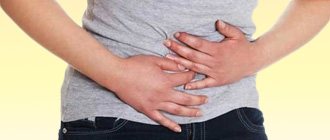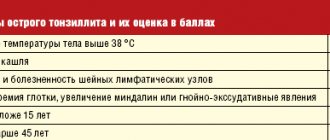Why does heartburn hurt?
The reflux of gastric juice with a food bolus into the esophagus, where normally there should be an alkaline environment, leads to irritation of the mucous membrane. The epithelium of the esophagus does not have a special protective layer from the aggressive effects of acid, which is located in the stomach. Therefore, the mucous membrane is damaged6. Erosion is formed - surface defects that do not affect the muscular layer of the esophagus. These wounds are additionally exposed to acid, which causes pain.
Heartburn is characterized by pain behind the sternum and in the epigastric region. It is quite easy to confuse it with the heart. A specific condition for pain in the esophagus is a direct connection with food intake7. In addition, heartburn and stomach pain worsen when bending over or in a horizontal position.
Diseases accompanied by heartburn and pain
Diseases whose symptoms may include heartburn:
- GERD (gastroesophageal reflux disease). Persistent relaxation of the esophageal sphincter, which is accompanied by frequent reflux of a bolus of food covered with gastric juice into the esophagus. A person does not necessarily feel every reflux. There can be several dozen of them per day.
- Gastritis. Chronic inflammation of the gastric mucosa, which in most cases is associated with the active proliferation of Helicobacter Pylori. There is also atrophy of the mucosa or, conversely, its excessive growth. The main symptom of gastritis: pain in the epigastric (upper) abdomen 20-30 minutes after eating. Additionally, signs of dyspepsia may be present: nausea, vomiting, belching, increased gas production.
- Peptic ulcer disease. The disease is characterized by the appearance of an ulcer on the mucous membrane of the stomach or duodenum. A characteristic sign: severe pain about half an hour after eating when located in the stomach and pain 1.5-2 hours after eating when localized in the duodenum. In the latter case, so-called “hunger” pain may occur.3
An isolated burning condition is characteristic only of GERD. For stomach diseases, heartburn is not a key symptom. But if a burning sensation behind the sternum is accompanied by pain in the right or left side of the abdomen, near the navel, then one may suspect diseases of the stomach or pancreas.
How to help the body if pain and flatulence do not leave you alone?
Flatulence is also one of the common manifestations of irritable bowel disease. Excessive accumulation of gases in the intestines and impaired elimination can lead to an unpleasant feeling of bloating, fullness in the abdomen, and increased pain. Sometimes flatulence can be triggered by stressful situations. The symptom can manifest itself in a wide range of pain: pain can be constant, moderate in severity or cramping3.
The human intestines are full of bacteria. Together they form the intestinal microflora. The vital activity of bacteria results in the production of gases - nitrogen, carbon dioxide, hydrogen and methane. If the number of bacteria does not exceed the norm, then the gases do not affect the functioning of the intestines and do not cause discomfort. However, as the number of bacteria increases, gas production may also increase4. The gases themselves can not only “inflate” the stomach, but also cause discomfort and also affect the functioning of the entire gastrointestinal tract. Such changes in intestinal functioning lead to spasms, pain, flatulence and bowel dysfunction4.
What could be the cause of irritable bowel?
Irritable bowel disease can occur due to chronic stress or as a result of an intestinal infection. Irregularities in the intestines may be a reflection of emotional and psychological problems. This can be facilitated by an unfavorable psychological environment and psychological trauma.
As for irritable bowel pain, it can manifest itself due to spasm caused by increased sensitivity of intestinal receptors during contraction and stretching of its walls7.
Irritable bowel disease is functional in nature and is associated with impaired intestinal motility. The walls of the intestine are covered with smooth muscles, which in normal condition, when contracting, form a “wave” that contributes to its normal functioning. If the intestines are contracted, the rhythm of contractions is disrupted, which can lead to spasm and pain. Spasm of various layers of intestinal muscles can lead to bowel problems (diarrhea or diarrhea)9. In this case, inflammatory or structural changes in intestinal tissue do not occur5.
How to help the body if it is often bothered by irritable bowel symptoms?
In addition to pain, irritable intestines can remind themselves of bowel movements, flatulence (gas formation, bloating and rumbling)3. You can relieve symptoms individually one-time with various drugs, but you need to understand that the symptoms will return again and again as long as intestinal motility is impaired - the cause of the complex of symptoms. Therefore, to treat irritable bowel it is important not only to eliminate various symptoms, but also, above all, to restore its proper functioning.
Duspatalin® 135 mg can help with this - an original drug that is specially designed to treat the entire complex of irritable bowel symptoms.
Diet for heartburn and stomach pain
Therapy for burning sensation behind the sternum begins with lifestyle changes, including nutrition. Features of the diet to prevent weakening of the esophageal sphincter5:
- Products not recommended for consumption: carbonated drinks, coffee, strong tea, chocolate, baked goods, fast food, fatty foods, canned food, smoked meats, fruit juices, tomatoes and their derivatives, seeds, nuts, cabbage, sour fruits, black bread, pasta, radish, onion.
- It is recommended to drink enough water per day.
- It is recommended to enrich the diet with vegetable fats, such as legumes, and limit animal fats.
- The diet should be enriched with various vegetables, steamed or baked.
- The use of large quantities of spices is not recommended. Spicy foods will be especially harmful.
Additional recommendations regarding diet:
- Meals should be regular (3-4 times a day in the absence of other recommendations from a doctor).
- Portions should be small.
- After eating, a short walk in the fresh air is recommended.
- After eating, it is not recommended to bend over or lie down.
- It is recommended to sleep with the upper half of the body elevated.
- Clothes should be loose, without tight belts.
Also, to successfully combat a burning sensation in the chest, you need to stop smoking, drinking alcohol, and increase physical activity.
Vasilenko V.V. About belching and periodic vomiting / www.GastroScan.ru
| Authors: Vasilenko V.V. |
Belching
Belching is the most common “digestive symptom” that patients unknowingly associate with any digestive disease.
In fact, the reason lies in a disorder of the nervous regulation of digestive functions. In other words, the more you think about belching, the longer it will bother you, the less you think about it, the faster it will go away. There are no universal methods of drug treatment yet - regular autogenic training and breathing exercises can give results (the method is outlined below).
Meliora probant, deteriora sequuntur. - I praise the good, but I am drawn to the bad
Belching air can occur after a vigorous meal in anyone.
Moreover, sometimes excessive burping becomes habitual. People with neurological disorders who swallow a lot of air outside of meals belch air constantly.
Dysregulation of the motor function of the stomach leads to severe and persistent belching. Aerophagy is an unconscious act that is not necessarily associated with food intake. During one swallowing movement, 2–3 ml of air enters the stomach. Typically a person swallows 600 times per day. Aerophagia, as one of the official independent so-called functional gastroduodenal disorders, is characterized by a feeling of fullness in the epigastric region, which occurs as a result of excessive swallowing of air and decreases after belching with air. It should be remembered that air is not formed in the stomach, but gets there when it is involuntarily swallowed and is retained.
In order to overcome persistent belching, it is necessary to carefully master any of the abundant systems of self-relaxation, meditation or autogenic training, and at the same time search for and select a suitable psychotropic medicine with the help of a doctor. A powerful suggestion can have an unexpectedly quick effect: medical hypnosis (unfortunately, there are practically no specialists) or the psychological influence of strong personalities - be it Kashpirovsky, a healer, a healer or a clergyman (medical education does not play any role). Sometimes, as Montaigne said, one simply “must be able to endure what cannot be avoided.”
It is impossible not to mention the vomiting syndrome, which often misleads children’s doctors and “adult” doctors.
Periodic vomiting
Since 1882, the syndrome of periodic vomiting has been known, appearing in otherwise completely healthy children.
It has two variants of its course: classic - monotonous episodes of nausea and vomiting of varying duration are observed (and intervals of normal well-being can last for weeks and months); chronic - mild nausea with almost daily vomiting (reminiscent of some diseases of the digestive system). The faster the patient’s symptoms (pain, vomiting, diarrhea) disappear thanks to the medicine, the less inclined he is to follow other medical recommendations - quitting smoking, diet, etc. Unfortunately, even a clear explanation that improvement does not mean recovery is far from doesn't always help. N.V. Elshtein
The conditions are similar, but with certain features. They are also found in adults. They can last for years and even decades. In some cases, triggering factors are found - usually stress (not only negative, but also positive), and in women also the onset of menstruation.
First, nausea is felt, which is accompanied by general and muscle weakness. Then there are attacks of uncontrollable vomiting, often with bile or even blood, and abdominal pain.
In about a quarter of patients, body temperature and blood pressure increase, and the pulse quickens. General blood tests do not reveal inflammatory changes. In this phase of the syndrome, features of psychotic behavior are often observed. Then the attacks (reminiscent of vomiting in pregnant women - early toxicosis, as well as the so-called hysterical vomiting) suddenly or gradually stop.
Between episodes of vomiting, two-thirds of patients experience migraines, panic attacks, signs of anxiety or mood disorders, and alcohol or drug abuse.
Only a doctor, based on strictly defined criteria, can diagnose periodic vomiting syndrome and its phase by analyzing the family history and manifestations of the disease, excluding other probable causes of nausea and vomiting that can be successfully treated.
What is now considered a drug will become poison tomorrow. So what? The sick will again consider this poison a medicine. Rudaki
However, the correct diagnosis is usually made late, and treatment also leaves much to be desired. Patients repeatedly turn to doctors and, at their insistence, repeat examinations to no avail.
Thus, the results of observation of 38 people with periodic vomiting syndrome showed that in total they underwent 62 gastroscopy and 17 operations (usually removal of the gallbladder).
Long-term studies confirm a favorable prognosis in terms of physical health and the absence of serious complications. The general recommendation for the acute phase of periodic vomiting syndrome is to create conditions for maximum rest and prolonged sleep. If necessary, an individual selection of medications is possible to reduce the frequency of exacerbations, pause the process, speed up recovery, and alleviate the symptoms of exacerbations.
Therapeutic breathing exercises
In some cases, special physical therapy can significantly improve a person’s well-being and general condition.
However, in case of serious diseases of the lungs or bronchi, before mastering a set of exercises, of course, you need to consult a doctor.
Breathing exercises are mastered in three stages. When performing each exercise, it is important to mentally imagine the nature of the movement, its connection with breathing and the pace of execution. The original system of exercises was proposed by I.B. Temkin, O.A. Sheinberg and P.I. Anikeev. It should not be viewed as something obligatory and unchangeable. After gradual, solid mastery, these exercises should be included separately in morning gymnastics complexes, in other independent physical education classes; they can be performed during walks and even during lunch breaks.
When mastering gymnastics, practice in the fresh air or on the balcony, in the bedroom with an open window and, if possible, alone. Do the exercises daily, preferably 20 minutes every day rather than an hour twice a week. Clothing should be soft, loose, and not restrict movement.
Music is not required, but Chopin or Tchaikovsky, rather than peppy rhythms, will help you relax and switch over.
First stage
Mastering the first stage usually requires 10–12 independent sessions with a gradual increase in the duration of the exercises. With the help of an experienced physical therapy methodologist, you can master gymnastics three times faster.
A. Static
breathing exercises (lying on your back, side, sitting and standing).
- Rhythmic nasal breathing with the mouth closed at a normal pace (duration 30–60 seconds).
- The same thing with mentally counting the number of inhalations and exhalations through the nose (15–30–60 seconds).
- Rhythmic breathing through one nostril while holding the other nostril with your hand, alternately 3-4 times (30-60 seconds).
- Abdominal breathing. Trying to keep your chest motionless, while inhaling, protrude the front wall of your abdomen as much as possible, especially its lower part. As you exhale, vigorously draw in your abdominal wall. For visual control of the correct movements, hands should be held on the chest and stomach (4-8-12 times).
- Chest breathing. Trying to keep the front wall of the abdomen motionless, while inhaling, expand the chest as much as possible. When exhaling, on the contrary, the chest should be vigorously compressed. Breathe through your nose. For control, the hands are on the sides of the chest (4–8–12 times).
- Full breath. As you inhale, expand your chest while simultaneously protruding the front wall of your abdomen. Exhalation begins with a vigorous retraction of the abdominal wall and subsequent compression of the chest. Breathe through your nose. For control, one hand is on the chest, the other on the stomach (4-8-12 times).
- Exercise in voluntarily slowing down the breathing rhythm and simultaneously deepening it, breathing through the nose (30–60–120 seconds).
B. Dynamic
breathing exercises (there is only one in the first stage).
- Uniform nasal breathing combined with walking at a slow pace (in place or in motion). It can be carried out in the form of imitation of walking from starting positions lying or sitting. The exhalation is slightly longer than the inhalation, both phases are performed for a certain number of steps (60–120–180 seconds).
Second stage
At the first stage, you have to consistently learn static breathing exercises for conscious mastery of the breathing mechanism and the ability to control it.
The second stage involves the use of static breathing exercises of the first stage and additional static exercises, as well as dynamic exercises. At this stage, special attention is paid to the ability to voluntarily change the rhythm, tempo and amplitude of breathing movements. Mastering it usually requires 10–12 independent sessions with a gradual increase in the duration of the exercises.
A. Static
breathing exercises (lying on your back, on your side, sitting and standing).
- Uniform breathing with inhalation through the nose and jerky, in 2-3 steps, exhale through the mouth (3-6 times).
- Even breathing with inhalation through the nose and extended exhalation through the mouth while pronouncing vowels or consonants (3-6 times).
- Method of breathing with counter movements. During inhalation, the chest expands and the abdomen retracts. Accordingly, when you exhale, the chest contracts and the stomach protrudes. Perform the exercise rhythmically, without tension and silently. Breathe through your nose (4–8–12 times). This exercise is borrowed from Chinese breathing exercises.
- Inhale slowly through your nose. Exhale in one quick movement through the mouth. Then hold your breath for 3-5 seconds (4-8 times).
- Take a quick deep breath in through your mouth, exhale slowly through your nose (4-8 times).
B. Dynamic
breathing exercises.
- Lying on your back, sitting or standing, legs together. Raising your arms through your sides - inhale. Return to the starting position - exhale (3-6 times).
- In a sitting or standing position. Hands to the side. Voluntary breathing when rotating the arms in the shoulder joints back and forth - 4 times in each direction (4-6 times).
- In a sitting or standing position. Feet shoulder-width apart, arms bent, hands clenched into fists. Strikes simulating boxing strikes (8-10 times with each hand). Breathing is uniform.
- Lying on your back, sitting or standing. Feet together, hands on waist. Taking the straight leg to the side and returning to the starting position - inhale, pause - exhale (6-8 times in each direction).
- Lying on your back, sitting or standing. Legs extended together, arms down. Alternating bending of the legs at the knee joints. When performing the exercise, exhale, when returning to the starting position, inhale (6-8 times with each leg).
- In a sitting or standing position. Feet shoulder-width apart, arms along the body. Bend the torso forward - exhale, return to the starting position - inhale (4-8 times).
- Lying, sitting or standing. Feet together, arms to the sides. Bend the torso to the sides. When performing the exercise, exhale; when returning to the starting position, inhale (4–8 times in each direction).
Third stage
The third stage is the development of breathing skills under conditions of increased stress, the development of correct breathing when performing household and professional stress. Classes include breathing exercises during long walks, sports exercises or games, etc. The duration of mastering this stage is longer - 30–35 independent studies.
A. Static
breathing exercises.
Starting position: standing, feet shoulder-width apart, knees slightly bent, tailbone, heels and crown in line. Look straight ahead. Relax your shoulders and lower them. Place your hands on your stomach.
I. Mastering the rules of diaphragmatic breathing: while inhaling, lower the diaphragm, protrude your stomach slightly. As you exhale, on the contrary, draw in. The exhalation is slightly longer than the inhalation. Breathe evenly through your nose at your usual pace. Match your movements to your breathing, not the other way around. II. The actual exercises.
- Practice diaphragmatic breathing with your eyes closed (this will help you concentrate). Do not hurry! Practice your breathing until it becomes natural for you, and only then add new movements.
- As you exhale, bend your knees, and as you inhale, straighten them. Move up and down, constantly adjusting to your breathing. The lower you sit, the greater the load.
- Imagine that your hands are lying on a cushion of air: palms at shoulder level, fingers “looking” down, elbows slightly lowered. Don't pinch your armpits. As you exhale, squat, your hands lower to hip level, as if you are stroking the air. As you inhale, rise up, and also move your arms up (at first, to control your breathing, you can leave one hand on your stomach).
B. Dynamic
breathing exercises.
- Starting position: lying on your back. Legs together, arms freely (depending on the strength of the abdominal muscles). Going to a sitting position - exhale, returning to the starting position - inhale (6-8-12 times).
- Starting position: standing. Feet together, hands on waist. Squat - exhale, return to the starting position - inhale (6-10-15 times).
- Starting position: standing. Feet together, hands on waist. Jumping - breathing evenly (20–40–60 times).
- Even breathing when running in place or while moving at a slow to medium pace (30–60 seconds).
- Deep nasal breathing when walking up stairs along a planned route.
- Breathing when swimming is through the mouth; shortened energetic inhalation and extended exhalation.
V.V. Vasilenko. Sixty essays on digestion (recommendations from a gastroenterologist to patients) Back to section
Medicines for heartburn and pain
A common method for treating heartburn is to drink a baking soda solution, which reacts with the acid in the esophagus, neutralizing it. This method does temporarily relieve discomfort, but only for a short period of time. In addition, constant use of soda only aggravates the condition and is not recommended by any doctor.
Proven remedies for the treatment of heartburn and stomach pain:
- Proton pump inhibitors. Powerful antisecretory drugs that suppress the production of hydrochloric acid in the stomach and affect the mechanism of heartburn formation. The basic drug from this group is Omeprazole, which is the active ingredient of Omez® 10 mg. The recommended dose of Omez® 10 mg is 2 capsules per day. The effect of the drug can last for 24 hours. This is a convenient way to combat heartburn: capsules are taken 1 time 30 minutes before meals in the morning. The maximum possible duration of a course of the drug without a doctor’s prescription is 14 days4.
- H2 histamine blockers. Antisecretory drugs that are inferior in power to PPI7. Drugs rarely cause side effects when used in small doses7. Currently, proton pump inhibitors are preferred in medicine4.
- Antacids. The mechanism of action of antacids is to neutralize hydrochloric acid. In this way they relieve the symptoms of reflux, but do not have any effect on the formation of excessive amounts of acid in the stomach. Antacids1 act quickly and are often used as an emergency treatment. However, the duration of the effect of these drugs is short – a few hours1.
- Alginates. The principle of action of alginates is somewhat similar to the effect of antacids. Only they do not completely neutralize the acid, but form a layer of neutral medium between the mucous membrane and gastric juice3.
Treatment of heartburn accompanied by pain includes therapy for the underlying disease. A disease of the gastrointestinal tract can be suspected if taking the listed medications does not have a lasting effect within 2 weeks1. Changing your lifestyle along with timely treatment will help you avoid the complications of frequent acid reflux into the esophagus and prevent the occurrence of heartburn and abdominal pain.
THERE ARE CONTRAINDICATIONS, YOU MUST READ THE INSTRUCTIONS FOR MEDICAL USE OR CONSULT A DOCTOR.
When is burping normal and when is it pathological?
Belching is the involuntary release of gas or food from the upper gastrointestinal tract. There are physiological and pathological causes of belching. It is considered normal if it occurs due to swallowing air while eating (which often occurs in an infant) or drinking soda.
Normally, the air comes out gradually through the mouth, but if the pressure in the stomach increases, the muscles push the air through the esophagus, and belching appears. If the air is odorless and the heaviness in the stomach goes away within half an hour, then this is not a sign of illness.
Involuntary swallowing of air occurs if there is no nasal breathing, for example, due to an allergic rhinitis or adenoids, or if a person swallows air while talking.
Belching can occur if a person eats quickly, chews food poorly, drinks liquid through a straw, and also if food is washed down with water (stomach juice is diluted, which slows down digestion). Air from the stomach or esophagus can also escape when consuming carbonated drinks or foods that increase gas formation.
Abdominal pain and belching can occur due to poor diet (overeating, eating too much fruit, vegetables, legumes). Eating dinner before bed can cause abdominal pain and belching in the morning.
Pregnant women often experience belching due to the pressure of the uterus on the diaphragm and due to hormonal changes.
Constant unpleasant belching can be provoked by pathological processes:
- disturbance of gastric or intestinal motility;
- changes in the concentration of hydrochloric acid in gastric juice;
- narrowing of the esophagus or deterioration of the sphincters;
- inflammation of the bile ducts or pancreas;
- neurotic disorders.
If food stagnates in the stomach and begins to decompose and ferment, then the gases have an unpleasant odor. Such belching is regarded as a sign of gastrointestinal disease. Air comes out more often after eating and is accompanied by other symptoms of indigestion. As a rule, a feeling of heaviness, bloating, constipation or diarrhea.
If there is a malfunction of the sphincters, then severe heartburn appears.
Bibliography:
- Practical Manual of Gastroesophgeal Reflux Disease /Ed.by Marcelo F. Vela, Joel E. Richter and Jonh E. Pandolfino, 2013 –RC 815.7.M 368
- Danilov D.V. Modern possibilities for the treatment of erosive esophagitis / Danilov D.V., Shuleshova A.G., Bondareva K.A. // Evidence. gastroenterology. - 2022. - T. 6; No. 1. – pp. 26-30.
- Initial and maintenance therapy in patients with gastroesophageal reflux disease / Simanenkov V.I., Tikhonov S.V., Lishchuk N.B. // Med. alphabet. - 2022. - T. 1; No. 9 (306). — P. 8-12.
- INSTRUCTIONS for the use of the medicinal product for medical use OMEZ®10 mg LP 00328 dated 07/11/17 Date of access 11/26/18
- Kardasheva, S. S. Gastroesophageal reflux: new treatment prospects / Kardasheva S. S., Shulpekova Yu O., Leshchenko V. I. // Med. advice. - 2022. - No. 11. - P. 92-99.
- Tarasova, G. N. Pathogenetic features of damage to the mucous membrane of the esophagus during gastroesophageal reflux disease / Tarasova G. N., Smirnova E. A. // Consilium Medicum. - 2017. - T. 19; No. 8-2. — P. 7-12.
- Trukhan, D. I. Current aspects of antisecretory therapy of gastroesophageal reflux disease / Trukhan D. I., Grishechkina I. A. // Med. advice. - 2022. - No. 15. - P. 28-35.










